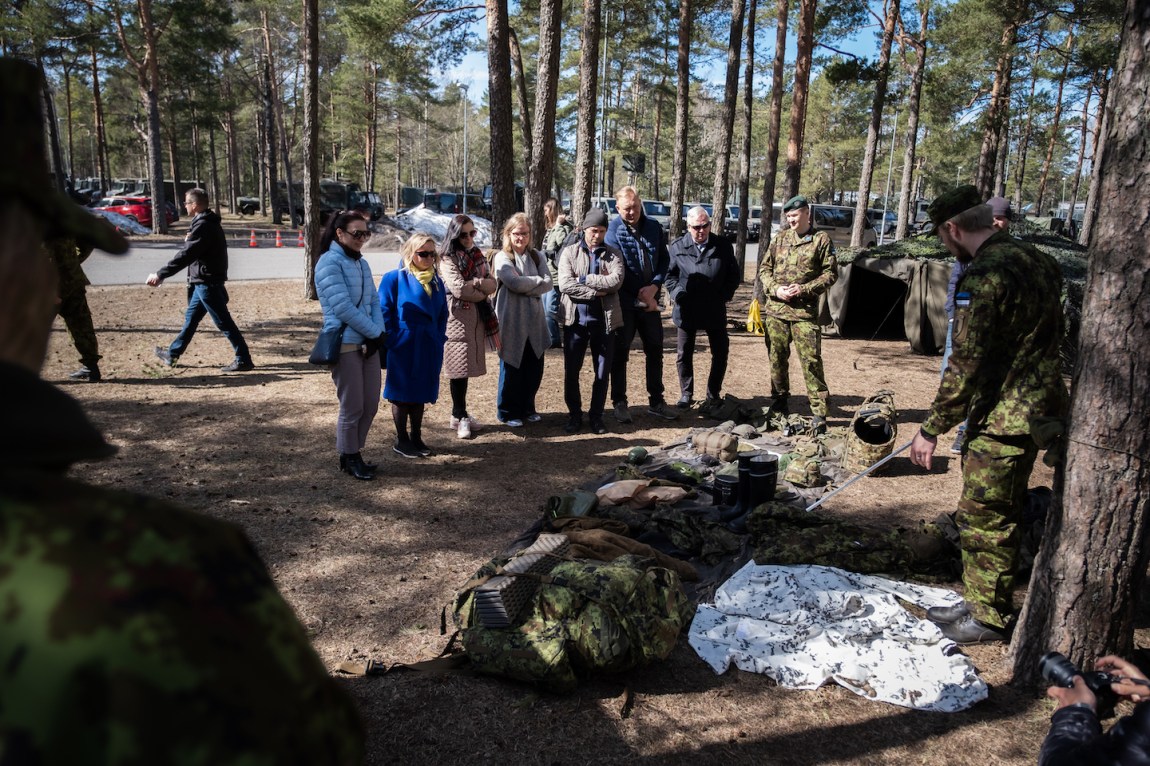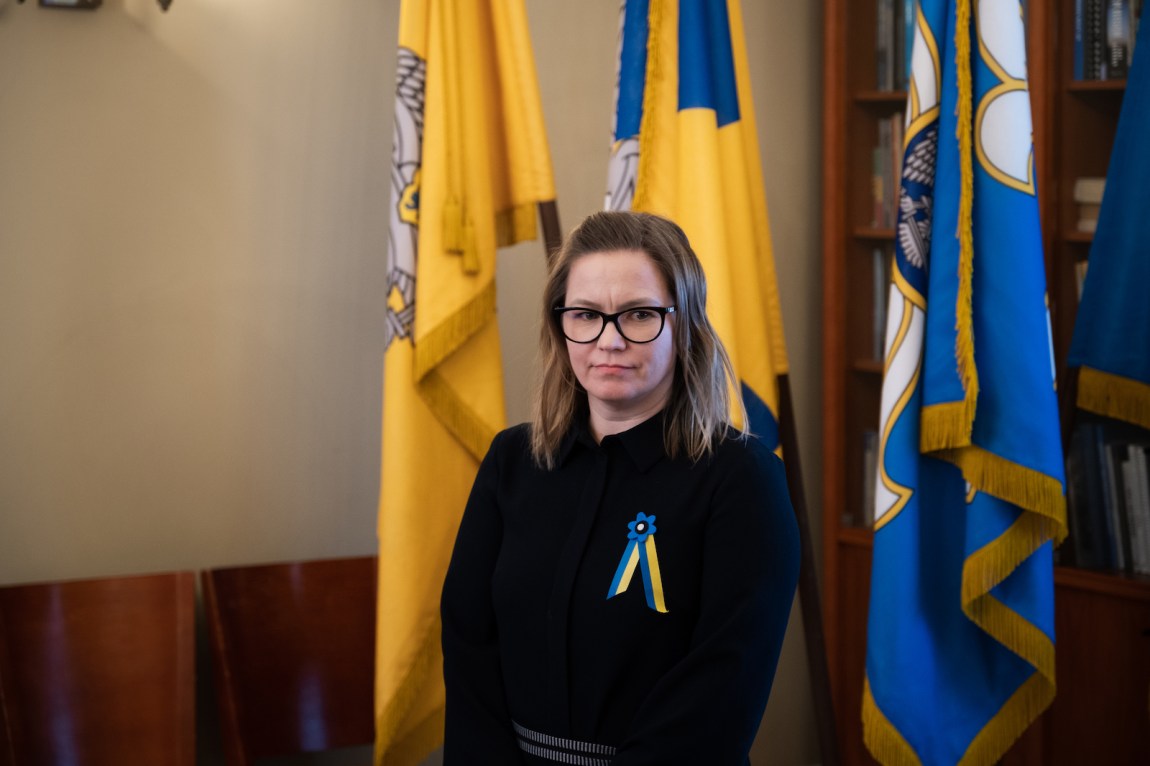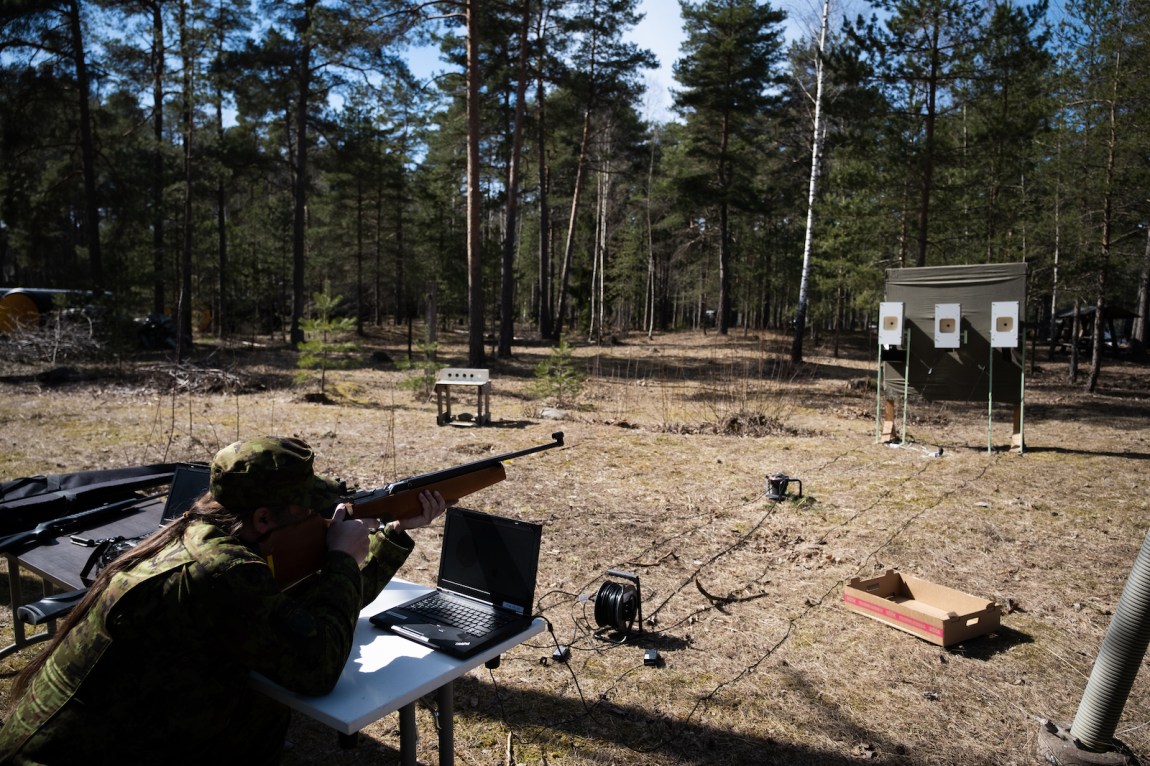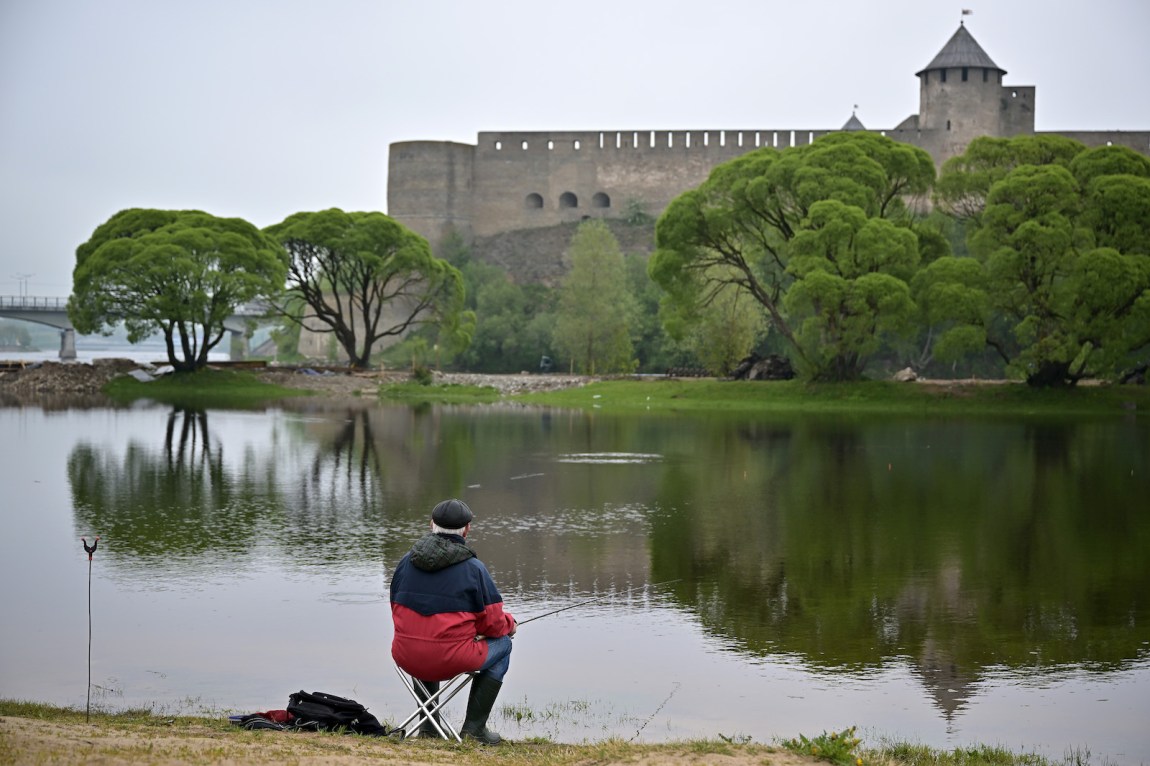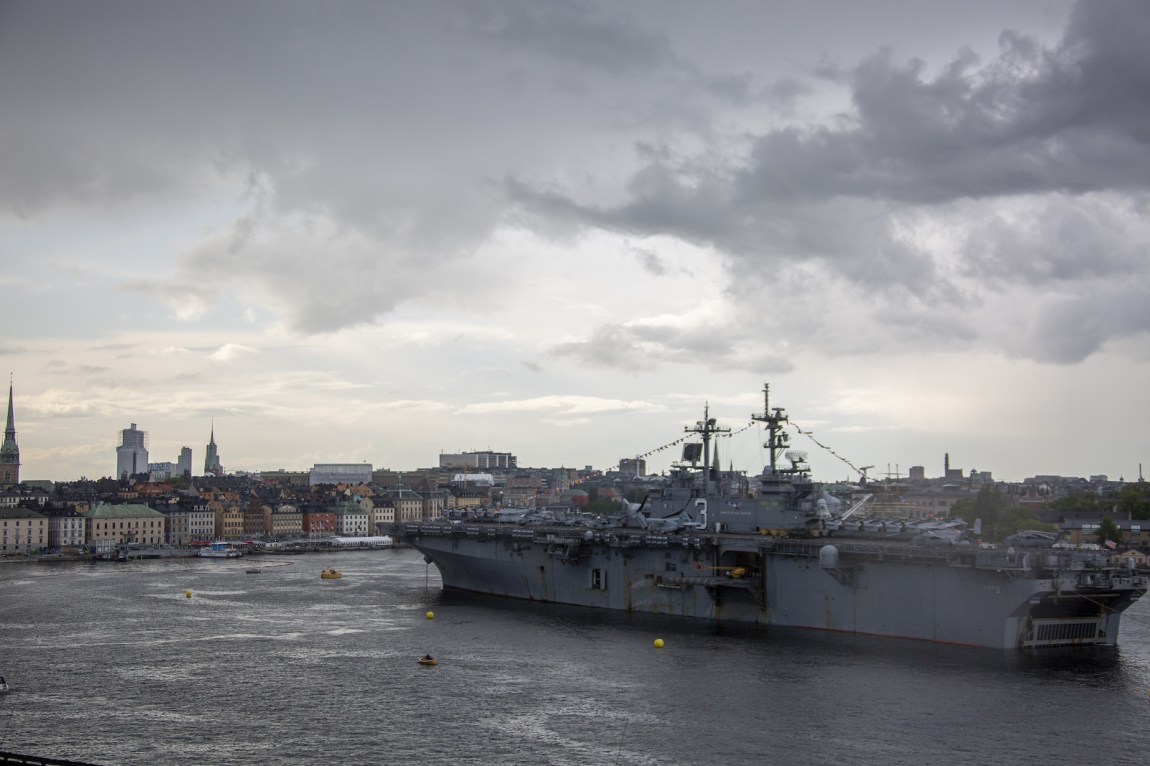“Putin is our main recruiter,” Elisa Jakson said to me, gesturing at a formation of a hundred or so new members of Naiskodukaitse, the women’s branch of the Estonian Defense League. In the forest south of Tallinn, Estonia’s capital, Jakson was standing in a clearing next to a green military cannon. She was dressed in athleisure, like most of the new recruits who’d come for basic training that weekend.
When Putin invaded Ukraine on February 24, Estonians were marching in a parade to commemorate their country’s independence from Russian and German troops on the same day in 1918. Thousands of civilians soon enlisted in the defense league, and now many of the new recruits were here, lining up for a morning salute at seven AM on a Saturday in June. Behind them, the training building sat in the shadow of an abandoned Soviet-era grain factory, looming and decrepit, its windows blown out. “People thought that this cannot be happening in the twenty-first century,” Jakson said of the war in Ukraine. “It’s like our history lessons are happening there right now.”
The women, chipper and determined, had their names written in Sharpie on masking tape stuck to their shirts. They were bankers, cleaning ladies, garbage truck drivers, startup founders, doctors, politicians—a cross section of the Estonian population, which is about the size of Russia’s standing army. “If something were to happen here, I’m not prepared,” Lisa Garder, wearing a black tracksuit, told me. She works at a logistics startup and spent fifteen years living in the US, in New York and Los Angeles. “What would I do?” she said. “Yes, now we have NATO and the EU, but it is all so recent. It feels very fragile.” I walked through the woods with her and her friend Liina, who wore her long blonde hair in a bun. “I have seen guns, but I have no idea what to do with them,” said Liina. “I am not that kind of human who wants to do it every day. Only if we go to war. I will know how, and I will use it.” We walked to a classroom, where we sat under fluorescent lights in front of a Powerpoint presentation on how to clean and load rifles.
After their training with the guns the group moved to a trench, where they studied face-painting techniques as part of a lesson on camouflage. Ingrid Nielsen, a new member who works at the Estonian Fund for Nature, told me that her parents were terrified when Russia invaded Ukraine. “They were sure we would be next.” The Estonian Defense League (EDL) had grown by nearly 3,500 people since February, more than a thousand of them women in Naiskodukaitse.
*
The Baltic states were part of the tsarist Russian empire and then the Soviet Union, and today they each maintain significant Russian-speaking minorities. In this small country at NATO’s easternmost flank, the recent history of Soviet occupation is vividly ingrained; members recalled their grandparents’ deportations to Siberia and their own childhoods before re-independence. “We are very much united by bloody Russian history during the last hundred years,” Marko Mihkelson, chair of the Foreign Affairs Committee of the Estonian Parliament, said when I visited him at his office. A Ukrainian flag hung outside the Parliament building in Tallinn, opposite a nineteenth-century Russian Orthodox cathedral. “It connects people directly to what’s happening in Ukraine—it’s why people are so eager to show not just solidarity but also a personal will to defend.”
Going around Tallinn asking if Putin would invade the Baltic states next seemed as tiresome as asking if the US is headed for civil war. But the question kept coming up. On June 9, in Moscow, while visiting a new multimedia exhibition honoring tsar Peter the Great’s 350th birthday, Putin mused on the tsar’s conquest of the Baltic coast in the eighteenth century: “He took back what had always belonged to us…. It seems now it’s our turn to get our lands back.” The following week, Yevgeny Fyodorov, a member of the Russian Duma, submitted a proposal to withdraw Lithuania’s independence, then went on to suggest that Russia revoke its recognition of the independence of Estonia and Latvia. On June 21 Russian authorities threatened retaliation after Lithuania, in accordance with EU sanctions, blocked rail transport of goods between Moscow and the Russian exclave of Kaliningrad. “We see from history that a threat is actual and not just theoretical,” one new member of the EDL told me, echoing a line I heard dozens of times on my visit. “We are doing everything we can to prepare.”
Since the war started, Estonia’s prime minister, Kaja Kallas, who was herself born in Soviet-occupied Estonia, has been recast as Europe’s Iron Lady. Her mother, grandmother, and great-grandmother were deported to Siberia; her great-grandfather was a commander of the EDL. Estonia has contributed a larger portion of its GDP to military aid for Ukraine than any other country in the world. “Every Javelin we send over there is one fewer Russian tank on our border,” Estonia’s former president, Toomas Hendrik Ilves, told me.
Advertisement
*
From the Middle Ages until 1914, the Estonians were subject peoples; they became independent for the first time in 1918, after seven hundred years of colonization and occupation by Sweden, Russia, Denmark, and Germany. “Until the beginning of World War I, the idea of an independent Estonia seemed a fantasy,” Mart Laar, Estonia’s prime minister in the 1990s, said. In August 1939 the Secret Protocol to the Molotov-Ribbentrop Pact was signed, effectively dividing Eastern Europe into Russian and German spheres of interest. As a result, roughly 80 percent of the Baltic German community left Estonia in the autumn of 1939. In June 1940, 90,000 Red Army troops entered Estonia, and in August 1940 the Estonian Soviet Republic was established.
The first mass deportations to Siberia took place in June 1941. In his history of modern Estonia, Neil Taylor notes that they were reported by the Soviet press as a voluntary transfer to the “happier East.” They entailed putting nearly ten thousand Estonians in cattle trucks, men separated from women and children, and “dumping them separately, like unwanted garbage, all over Siberia and Central Asia,” as the diplomat Irena Wiley wrote at the time. The Estonian president, Konstantin Päts, was deported to Leningrad and later sent to prison, branded as mentally ill for maintaining that he was the president.
Many Estonians remember the subsequent German occupation, from 1941 to 1944, more favorably; Timothy Snyder writes in Bloodlands: Europe Between Hitler and Stalin that the Germans were seen as liberators, and other historians note that the Nazi regime allowed considerably more freedom of Estonian cultural expression than the Soviets had. “All 963 Estonian Jews who could be found,” in Snyder’s words, were killed by the Estonian Security Police under German authority, and thousands of Jews were brought from other countries to Estonia to be murdered. In 1944 the Red Army returned to Estonia, and the country came back under Soviet control. The second mass Soviet deportations took place in March 1949.
In a country so frequently occupied or on the precipice of occupation—Soviets, Nazis, Soviets again—the memories of 1939, 1941, and 1944 shrouded the new freedom of 1991 with unease. The resistance to these invasions remains a resonant symbol of national unity, though the darker underside of the freedom fight is less prominent in national memory: during the German occupation, double collaboration was common, and some anti-Soviet Estonians known as the Omakaitse, the Home Guard, killed Jews.
The EDL was one of the Estonian nation’s first institutions, established at the end of World War I by armed citizens who wanted to defend their newly independent country. During the 1918 war of independence against the Bolshevik invasion they organized internal defense. The league was liquidated in 1940 when the Red Army arrived, though some members fled to the woods and participated in the resistance as “Forest Brothers,” anti-Soviet guerilla fighters. In 1941 the Forest Brothers fought the Red Army in the Summer War; by 1944, the group was composed of Estonians who’d served with German troops, people who wanted to avoid being conscripted into the Red Army, and former members of both the Defense League and the Home Guard. Some of their old weapons were passed down to the EDL when it was reestablished in 1990.
Living next to Russia, “you never have peace,” Riho Ühtegi, the commander of the EDL, told me when we met at the League’s headquarters in the center of Tallinn, just outside of the Old Town. The existential threat of invasion feels so profound that most every family has a plan in case of crisis, he explained. Civilians keep their state-issued weapons at home. Ühtegi called the EDL a “total defense concept…where all of the nation acts somehow in defending the state.” He elaborated, “we are a really small nation, and we’ve seen how nations who are bigger than Estonia didn’t survive.”
At a Helsinki Commission hearing three weeks after the war in Ukraine started, US Congressional Representative Steve Cohen told the committee, “I suspect if the three Baltic countries were not members of NATO, you might have already met Vladimir Putin’s armies.” The defense of Estonia, Latvia, and Lithuania—each of which joined NATO in 2004—was one of the crucial topics at NATO’s Madrid summit in late June. Prime Minister Kallas said that Estonia would be “wiped off the map” by a Russian attack unless NATO increased its defense of Eastern Europe. As “tripwire” states, under NATO’s current strategy, the Baltics can be occupied for 180 days before NATO moves in to defend them. If Russia were to link its troops in the exclave of Kaliningrad with those in Belarus, it could close the Suwalki Gap, a sixty-five-kilometer-wide sliver of land that separates Lithuania from Poland, and effectively cut off the Baltics from the rest of NATO. In April Kallas recommended that NATO establish permanent bases in each Baltic state, and that NATO fighter jets should be allowed to shoot down enemy aircraft. The summit resulted in the largest escalation of NATO defenses since the cold war, and a sevenfold increase in the number of troops on high alert; the US sent F-35 fighter jets to the Estonian air base. Neighboring Latvia reinstated compulsory military service, which had been eliminated in 2007. “I no longer have faith in deterrence,” said Martin Herem, the Commander of Estonia’s Defense Forces, on a talk show in June.
Advertisement
*
Early Sunday morning at the training headquarters, there was a drop-off line, as though for school, and women and men in fatigues got out of their cars or off their bikes and lined up for attendance and salutes. I joined a group of new recruits who were in a forest clearing learning to assemble their equipment into backpacks, and sat with two men who’d been conscripted into the Soviet Army in the 1980s. When they logged into the e-portal to register for the EDL in late February, they were both surprised to find that their files had been transferred from the Soviet Army, giving a record of their having been sergeants. “Thirty years ago, you served as a conscript, or you went to jail,” one of them, who works at a bank, told me. “We did not have the choice. I was serving the army that occupied my country. Now I am here as a volunteer with free will.” His friend had been the only Estonian member of his Russian brigade.
Some trainees sat on their sleeping pads to watch a presentation on how to use radios. Groups of women set off into the woods to locate coordinates based on military maps, radioing back when they’d found their destinations. They learned how to assemble a tent; the instructor passed around NATO food rations and batteries for headlamps and told them to sleep with their guns in their sleeping bags.
The men suited up in body armor and got into armored personnel carriers to go to a makeshift shooting range. I followed them with a member named Pia in her white Subaru. As we wound through suburban streets, she told me about taking riding lessons on horses that understood both Russian and Estonian. She turned onto a bumpy sand road beside a lake full of ducks, where the group assembled for a safety briefing before target practice. “We have a big enemy next door, and we have a bad history with them,” Indrek Hein told me. He’d considered joining the EDL for a decade, “but February 24 was D-Day for me. My five-year-old daughter was crying, and I realized the words I had for her were empty.” He paused, taking off his shooting glasses to wipe away tears and defog his lenses. “In 1940 Estonia didn’t do anything to fight for freedom. The Soviet Army marched in and that was all. We don’t want history to repeat. I lived my first fifteen years in Soviet Estonia. It’s impossible to think that it would return.”
During the week, Hein runs an online cosmetics store with his cousin. He stood alongside a man in his twenties—a popular Estonian bodybuilder and social media influencer—who’d gone to a liberal arts college in Minnesota. As they waited their turn to shoot, another member, Trinn, told me that “in 2014, when Putin annexed Crimea, I was gathering salt and oils and potatoes. In the long term, it didn’t seem realistic to do it alone.” Her friend Lina remembered participating in the Baltic Chain of 1989, a peaceful demonstration during which two million people formed a human chain connecting Vilnius, Riga, and Tallinn.
Back at the training camp, the women returned from their map-reading exercise in the forest. The new recruits assembled in formation, laughing while marching between rows of Mercedes army trucks. The final team of stragglers arrived as the unit returned their rifles and dispersed to have cake and tea and lounge under the trees. The next weekend, the EDL would participate in a coastal defense exercise and shooting competition, and the Naiskodukaitse in a first-aid competition that included a highly realistic simulation of a woman giving birth in the forest. In the calm of training, the war they were preparing for felt far away.
*
Grete Arro, a prominent educational psychologist at the University of Tallinn, joined the Defense League in 2008 immediately after Russia’s invasion of Georgia and is now a sergeant. “We have no illusions,” she said of Ukraine. “You take your worst nightmare, and you triple it.” We met at a café opposite the Fotografiska Museum in the newly developed neighborhood of Telliskivi. She wore a black cocktail dress and drank grapefruit juice as she described her training alongside thousands of NATO troops in the final days of Estonia’s annual spring military exercise. She’d led a group in an intelligence-mapping drill that simulated how to respond if the enemy attacks not from the east, but from the south, through Latvia. Several months pregnant, Arro was at first hesitant about participating, but her second-in-command was pregnant too.
“We had to decide how to position ourselves. Maybe we need mines here, maybe we will demolish this bridge. Which houses could cover us? Modern houses aren’t so steady.” Other areas covered in her Tallinn-based training included urban warfare and how to secure Toompea Castle, where parliament meets; the airport; and the presidential palace. Her team had struggled trying to figure out how to suit up in riot gear in the dark.
In our conversation she emphasized that, in a country as small and vulnerable as Estonia, everyone must be “more than one person.” She went on, “Why do the men have this moral obligation to protect me? Who should die for me? We’re a nation of 1.3 million people—it’s not only simple people who fight here. The whole country is mobilized.” After February 24, she saw other professors from her university at basic training. The group’s membership has always comprised a range of citizens; Marina Kaljurand, the former ambassador to both the US and Russia, and minister of foreign affairs in Taavi Rõivas’s independent cabinet, does evacuation trainings from her summer house during recess from European Parliament in Brussels.
During the occupation, Arro’s great-grandfather was deported to Siberia, and her grandparents’ farm was demolished. “Everyone was killed,” she said, “everything was burnt.” Decades later, after independence, her mother recovered the land and today runs a small hotel on the property. “Many, many Estonian families” have stories like this, Arro says, and even those who haven’t experienced occupation have “secondary trauma.” “Although I live in Tallinn and work at a university, I am still in close contact with all that happened. The wound of occupation—you drive around Estonia, and you still see it has those marks in the environment.”
Later on, driving through Tallinn with former president Ilves in his Subaru, he pointed out new industrial-chic waterfront condos and breweries located down the street from dilapidated Soviet houses. “There is Estonian post-Soviet trauma,” he said. “The cold war, the 2007 Russian cyberattack here, the 2008 Russian invasion of Georgia, Putin annexing Crimea in 2014—each time one of these events happens, you see lots of people joining these home defense groups. The stories your grandparents told you weren’t exaggerations. What they did in Bucha is what they did here. It’s not new; it’s repeated. So of course there’s a sense that you’d better do something. You don’t want Russia to think that changing borders by force is viable.”
Ilves was flying to Bahrain the next day to give a speech on digitization, one of his main causes. While he was president, Estonia was hit by devastating Russian cyberattacks following the relocation of a Soviet World War II memorial in Tallinn, a decision that also sparked rioting and looting by members of the Russian population. Under Ilves, Estonia became the first “digital nation,” offering almost all of its government and private services online and becoming a world leader in cyber security—a national defense that is augmented by the EDL’s voluntary Cyber Defense Unit. Ilves, an EDL member himself, said that these days he prefers to engage in defense by tweeting to his 172,200 followers on Twitter. We were talking about what seemed like two different eras of war. I took a Bolt—Estonia’s version of Uber—back to the woods.
*
The next morning I took a bus east to Narva, Estonia’s third-largest city. Across the narrow Narva River is the Russian town of Ivangorod; medieval fortresses sit on each country’s riverbank, facing each other. From Narva Castle, I watched a man sitting on the Russian side; another sat alone on the Estonian side, his fishing line in the water. The Estonian side is far more developed than its Russian counterpart, despite the architectural hangover of Soviet-era apartment complexes. In the same speech in which he compared himself to Peter the Great, Putin went on to say of the tsar’s conquest of Narva: “He was returning and reinforcing, that is what he was doing.” In 1940 Soviet troops entered Estonia through Narva, and many see the narrow river as a vulnerable site of possible invasion. Now, some of the nearly two million Ukrainians who’d been forcibly transferred to filtration points in Russia come over the Narva border into Estonia as refugees. At the border crossing, trucks and a yellow Porsche queued for a customs check. Opposite the pedestrian bridge was an LED screen promoting a crisis app Naiskodukaitse had developed, #BePrepared.
At the EDL training, I’d heard the same line about defending Estonian autonomy, a portrait of unity that doesn’t encompass all of the country’s citizens—not least its significant Russian minority. The population of Narva is 97 percent Russian-speaking, and over a third have Russian citizenship. Yana Toom, a local politician serving in the European Parliament, told an NPR interviewer in May that denouncing Russia’s invasion of Ukraine and expressing support for sanctions “was a kind of political suicide,” given that many of her constituents, particularly those of the older generation of Russians, support Putin’s expansionism. But Estonia’s Russian population is not itself unified; for example, the eastern district of the EDL offers training in Russian for those among them who want to train as civilian volunteers. Ethnic Russians can also be Estonian patriots, and even among Russian citizens in Estonia—94 percent of whom were in favor of Putin in February—some see a “fifth column” developing as the group starts listening more to Estonian media outlets than Russian ones and deciding to support Ukraine.
Back in Tallinn I met Indrek Kasela, a tech entrepreneur who’d donated a fleet of ambulances to Ukraine as soon as the war started. He owns a sleek sushi restaurant in Noblessner, the gleaming industrial waterfront, and we had a glass of wine at a new Ukrainian wine bar and clothing shop, where he told me about a crowd-funded startup event happening over the weekend and introduced me to volunteers organizing to bring supplies to the front “They’re the real defense league,” he said, gesturing to the Ukrainian women who ran the wine bar, as we walked behind them to his art-house cinema.
In early June’s White Nights in the northern latitudes it stays light out until close to midnight. Above the industrial city hall complex on the water, groups and couples drank beer they bought at the Circle K gas station, playing house music from Bluetooth speakers and smoking joints on graffiti-covered steps. At the bottom of the stairs, fishermen threw their lines into the Gulf of Finland. On the Tallinn waterfront, I saw new condos and hulking Nordic cruise lines with service to Helsinki; across the water, the enormous USS Kearsarge warship had just arrived in the port of Stockholm, an incongruous sight next to the tour boats.
The Kearsarge was in the Baltic Sea for NATO’s Baltic Operations amphibious assault drills. Once Sweden and Finland join NATO—they applied for membership in May—the Baltic Sea will become “NATO Lake,” punctuated by, as Ilves put it to me, “the little pimple of Kaliningrad.” Standing there, I thought of the journalist Sigrid Rausing’s description of encountering an old Soviet watchtower near a collective farm she lived on in the west of Estonia in the 1990s, with its sign in Russian instructing “what to do if an enemy was sighted at sea.” “There was such a strange dissonance,” she wrote, “between the sign, the tower, and the guard hut below, and the coastline itself: idyllic blue sea, the evening sun, a family of swans bobbing on the waves.”


